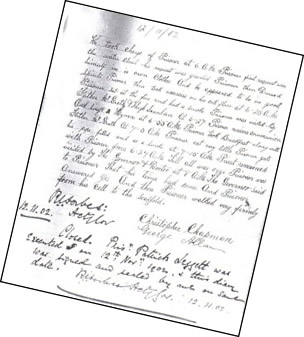On Saturday 13th September 1902, whilst John Bleakley was at sea, his only daughter Sarah Jane was murdered by her husband, Patrick Leggett. All the papers reported the story at the time and it was known as ‘The Whiteinch Murder’.

Patrick Leggett had been in trouble with the police since 1883 when he was only 11 years old, and over the next few years was birched on more than one occasion, sent to a reformatory and finally prison. He was released after serving three years and enlisted into The Gordon Highlanders Regiment only to be ‘drummed out’ for his drunkenness.
One of the families who suffered at least some of Leggett’s violence was that of his long suffering wife, Sarah Jane. He suspected her of going with other men and his jealousy and threats had finally led to her leaving him and staying with her brother, William Bleakley, and his family at 93 Wylie’s Backland. This was a very poor area of Glasgow that was also known as ‘Stablelands’ because the houses where once used for stabling horses and then converted to one room houses.
There were only a few houses in the row and at number 96 lived Sarah Jane’s cousin Christina Griffen, known by the nickname of ‘Teezy’. On the day of the murder, Sarah and Christina went to Partick, taking Christina’s baby with them. By the time they returned back to number 93 it was around 6pm and as the women entered the front door, it was Sarah who was carrying the baby in her arms. “Christ Teezy, take the bairn”, cried Sarah, and even as she handed the child over, Leggett stepped out from the doorway and delivered a heavy blow to the side of Christina’s head. She fell to the floor unconscious, and when she woke a few minutes later the room was filled with neighbours, along with a Doctor McCauley who was tending to the prostrate figure of Sarah.
In those few minutes Patrick Leggett had plunged a knife into his wife’s back. It had been Sarah’s screams that brought the neighbours, such as Mrs Douglas who lived at number 100 Wylie’s Backland and Elizabeth White, who had seen Leggett stab his wife and run from the close. Another neighbour, Elizabeth Harkness from number 97, would later testify that she heard Leggett threaten his wife weeks before. Patrick Leggett had escaped and ran down to the river Clyde where he threw himself in. Whether this was a genuine suicide attempt was debatable, for he was soon crying out for help. It was Donald McCallum, the ferryman at Linthouse who fished him out.
At his trial, Leggett’s defence was one of insanity. To counter this, the prosecution called, in addition to those already mentioned, John Bratton, a friend of Leggett’s who had been drinking with him on the day of the murder. Leggett had shown him a knife and said he was going to his wife’s home and “rip her up”. Professor Hugh Gault and Dr James Devon gave further evidence. Both examined Leggett and found no trace of insanity. In the event, the jury took only five minutes to decide he was sane and guilty as charged. The presiding judge, Lord Justice Traynor, then donned his black cap and passed the death sentence.
Whilst at Duke St. Prison awaiting the death sentence to be carried out, Patrick Leggett was watched night and day by the prison wardens. For the first time ever in prison history a diary was kept on Leggett. It listed everything from what he ate, drank, and smoked, to all his movements and his conversations with the guards.
This diary is now kept at The National Archives of Scotland in Edinburgh. Having read through it, its tells of requests he made to the prison governor – one asking for permission to write to his mother-in-law to ask for forgiveness, another to lay flowers on his dead wife’s grave. Both of these were denied.
The diary tells of how he speaks about his wife, saying she wasn’t really a bad wife and she was forever bailing him out of jail and would put up with his constant bullying and beating.
On Wednesday 12th November 1902, even though a petition with over ten thousand signatures asked for mercy, Patrick Leggett walked to the scaffold without a struggle. He was never visited by his family during his last weeks of life. The newspapers reported the hanging and told how a crowd of 2000 gathered in Cathedral Square waiting for the black flag to be raised to signify that the death sentence had been carried out. Patrick Leggett had just become Scotland’s first man hanged in the twentieth century.
Sarah Jane was buried in common ground (Lair 467 section A) in the Western Necropolis, Maryhill. Patrick Leggett was interred among lime shells and buried beside the north west wall of Duke St Prison, water was later poured into the grave to consume the remains.
weejock
© weejock 2010
Sources
The main source of information on this story was from the newspapers at the time, and the trial papers from the National Archives of Scotland.